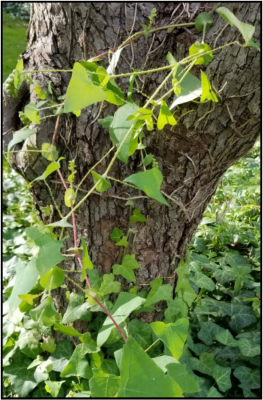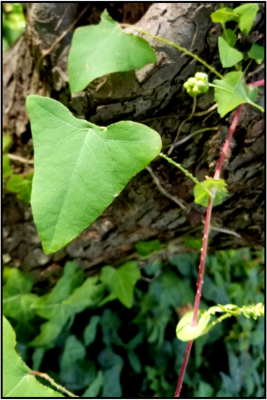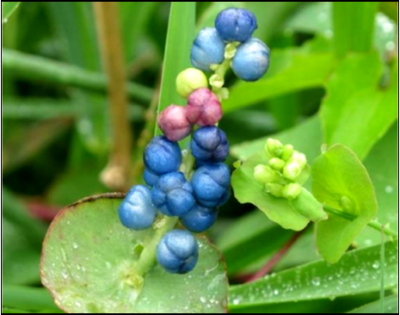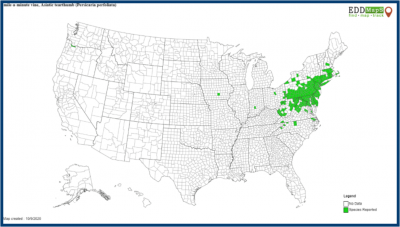Polygonum perfoliatum, syn. Persicaria perfoliata
By Victoria Wallace and Alyssa Siegel-Miles, UConn Extension
Identifying Features
- OVERVIEW: Trailing herbaceous annual vine with back-ward-hooked barbs over the stems, flower and leaf stalks, and veins on back of leaves. Barbs become sharper as the plant matures. Climbs and sprawls densely over other plants, spreading outward 20-30 ft and suffocating native vegetation. Dead stems persist through winter, forming a tangled, interwoven mass over desirable vegetation.
- LEAVES: Alternate; shaped liked an equilateral triangle with a somewhat heart-shaped base when immature. 1 in wide at its widest point; vibrant green and barbed on the underside. Leaf-like, saucer-shaped ocrea encircle the main stem at the base of each leaf petiole.
- STEMS: Thin, angular, reddish stems. Covered in tiny hooked barbs, which allow the vine to climb on plants and other surfaces.
- FLOWERS: Inconspicuous, pale green; clustered on the short stems and originating from above the ocrea area. Flower production continues until frost. The seed re-quires an eight-week cold period in order to produce flowers.
- FRUIT: Emerges green, changes to purple, then matures to striking metallic blue fleshy, berry-like fruit produced from early summer until frost. About 0.25 in across and appearing in a long cluster at the vine’s tips above the ocrea area. Fruit is segmented, with each segment containing a single, small glossy black or reddish-black seed.
- REPRODUCTION/SPREAD: Reproduces by seed, which can remain viable for at least six years. Seeds germinate in early April. The fruit is eaten and seeds are dis-tributed by birds, deer, and small mammals. Seeds also move and are dispersed in soil or water in riparian and wetland areas. The fruit is buoyant for up to 9 days.



Habitat
Rapid colonizer of wetlands and streambanks. Invades open disturbed areas, such as fields, forest edges, roadsides, rights-of-way, and ditches. Grows best in full sun, but will tolerate partial shade. Prefers sites with moderate to high soil moisture. The vine’s rapid growth allows it to smother existing vegetation and restrict light availability, potentially killing plants below.
Control
When working with this plant, long-sleeved shirts and leather gloves should be worn as protection from the plant’s sharp barbs. Once a site populated with mile-a-minute vines has been cleared, replant with native species to reduce or prevent regrowth and monitor for new seedlings.
MECHANICAL CONTROL: Hand-pulling and mowing can be effective.
- Hand-pulling is the most practical approach for small populations. Start pulling vines once they are easy to see. Pull plants every three weeks from June to the first frost. Barbs harden as the plant matures, and the plant’s rap-id growth rate quickly produces large quantities of vegetative material and subsequent flowers and fruit, if plants are allowed to grow without frequent pulling. It is critical that plants are pulled before seeds are produced, which can begin as early as mid-June. Reduction of the seedbank will require at least 3-5 years of consistent effort and monitoring for new seedlings should continue indefinitely.
- Repeated cutting to ground-level (e.g., with shears, a string trimmer, or mower) will keep growth confined and prevent fruit set, which may reduce localized seed development. If seeds are present, inspect and thoroughly clean equipment after use to avoid seed dispersal to new locations.
CHEMICAL CONTROL: Follow label direction when using all chemical treatments.
- In areas with large mile-a-minute populations, or where location or access makes hand-pulling or mowing difficult, chemical control (pre- or post-emergent herbicide) may be a viable option. Location will dictate product type and scope of treatment. Consult with a licensed pesticide applicator. Refer to Penn State Extension’s Management Calendar or CIPWG’s Invasive Plant Management Calendar for more information.
BIOLOGICAL CONTROL:
- A beneficial weevil (Rhinoncomimus latipes), host-specific to mile-a-minute vine, has been released in Connecticut. Scientists from the University of Connecticut and The Connecticut Agricultural Experiment Station introduced approximately 18,000 weevils in 10 Connecticut towns for biological control of this invasive vine beginning in 2009.
DISPOSAL OF PLANT MATERIAL:
- Before June, when fruit is not yet evident, removed mile-a-minute plant material can be left on site to dry and decompose. After flowering begins, pulled plants should be bagged and destroyed. NOTE: After removal, green fruit may continue to ripen on extracted vines. Immature seeds can still germinate. Fruit and seeds should not be composted.
Distribution
Found primarily in the northeast United States, including significant infestations in Connecticut. Mile-a-minute vine can potentially expand to many other cooler areas in the U.S. It is estimated that mile-a-minute has spread to only 20% of its potential U.S. range.
Background
Native to Eastern Asia, India, and the Philippines, mile-a-minute vine was accidentally introduced several times into the U.S. from the late 1800s to the 1930s.

SOURCES:
- Connecticut Invasive Plants Council. (2018, October). Connecticut Invasive Plant List. https://cipwg.uconn.edu/wp-content/uploads/sites/244/2023/04/CT-Invasive-Plant-List-2018_Scientific-Name.pdf
- EDDMapS. (n.d.). Mile-a-minute vine, Asiatic tearthumb (Persicaria perfoliata). Retrieved March 2022 from https://www.eddmaps.org/species/subject.cfm?sub=3065
- Mad Gardeners, Inc. (n.d.). Mile-A-Minute Best Practices. https://www.madgardeners.com/
- New York Invasive Species (IS) Information. (2019, July 2). Mile-a-Minute. Cornell Cooperative Extension & SeaGrant New York. https://nyis.info/invasive_species/mile-a-minute/
- Pyle, C. (2002). Invasive Species Identification Sheet: Mile-a-minute Vine. United States Department of Agriculture. https://cipwg.uconn.edu/wp-content/uploads/sites/244/2013/10/Mile-a-minute-Vine-nrcs142p2_2015-0820x.pdf
- Templeton, S. Gover, A., Jackson, D., & Wurzbacher, S. (Updated 2020, July 16). Mile-a-minute. PennState Extension. https://extension.psu.edu/mile-a-minute
- United States Department of Agriculture Forest Service. (2005, March 7). Weed of the Week: Mile-A Minute Weed. https://www.invasive.org/weedcd/pdfs/wow/mile-a-minute_weed.pdf
- University of Connecticut Department of Plant Science and Landscape Architecture. (n.d.). Mile-a-minute Vine. https://mam.uconn.edu/
Questions? Contact:
Vickie Wallace
UConn Extension
Extension Educator
Sustainable Turf and Landscape
Phone: (860) 885-2826
Email: victoria.wallace@uconn.edu
Web: ipm.uconn.edu/school
UConn Extension is committed to providing equal access and full participation for individuals with disabilities within all our programs and activities. Visit s.uconn.edu/accessibility for more resources. UConn is an equal opportunity program provider and employer.
Funds to support the creation of this document were provided by the Crop Protection and Pest Management Extension Implementation Program [grant no. 2017-70006-27201/project accession no. 1013777] from the USDA National Institute of Food and Agriculture.
©UConn Extension. All rights reserved.
Updated March 2022
  |